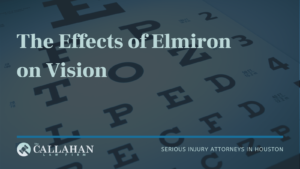The Effects of Elmiron on Vision

Elmiron (pentosan polysulfate sodium) is an oral prescription drug used by patients with interstitial cystitis to prevent and treat bladder pain and discomfort. Manufactured by Janssen Pharmaceuticals, the medication was originally approved for sale in 1996. It is the only drug that is FDA-approved to treat bladder pain associated with IC. According to the Internal Cystitis Association, between 1 and 4 million men and between 3 and 8 million women are affected by the disease, and experts estimate that hundreds of thousands of people have used the drug since its debut. Unfortunately, recent research has found that patients who have taken Elmiron are at increased risk of developing vision complications.
What is Elmiron Used For?
While Elmiron does not cure interstitial cystitis, it does work to provide relief from chronic pain caused by the condition. Patients with interstitial cystitis often suffer damage to their bladder walls. Stripping the bladder wall of its protective layer allows the irritants in urine to cause inflammation in the bladder. Unlike anti-inflammatories like ibuprofen, Elmiron does not relieve irritation by stopping the inflammation. Instead, it serves as a mild blood thinner and creates a barrier on the wall of the bladder to protect it from irritants in order to prevent irritation.
Can Elmiron Cause Blindness and Vision Problems?
While the most common side effects of taking Elmiron are described as mild and include diarrhea, nausea, headaches, upset stomach, and hair loss, recent research suggests that Elmiron could be toxic to the retina, irreversibly damaging the eyes of its users.
A study published in May of 2018 in the Journal of Urology identified the issue, noting the link between users of the Elmiron and the onset of eye issues. The study, published by a group of ophthalmologists with the Emory University Eye Center, was led by Dr. Neiraj Jain and Dr. William A. Pearce. In the study, Drs. Jain and Pearce wrote that six of their patients were found to have hyperpigmentation spots on their retinas, making it hard for them to read and adapt to low-light situations.
Dr. Jain and his team continued their research, and published another study in April of the following year. In it, they identified ten patients who were currently using Elmiron or had previously used it. All of the patients were experiencing similar symptoms of eye damage, despite having no history for retinal degeneration or pathogenic genetic mutations. They also noted that some patients with IC who did not take the drug were not experiencing these issues, and thus recommended patients stop taking Elmiron if experiencing negative symptoms.
In addition, they reported that they found users of the drug to have developed a “unique maculopathy.” Maculopathy is a broad term for any pathological condition or disease that affects the macula, a part of the eye in the back of the retina that serves as the focus of one’s central vision and controls one’s ability to see fine details, read, and recognize faces. Though there are several kinds of maculopathy, including age-related macular degeneration, hereditary maculopathy, and diabetic maculopathy, Dr. Jain defined this as pigmentary maculopathy, a type of maculopathy exclusively associated with Elmiron usage. Symptoms associated with pigmentary maculopathy can include hyperpigmentation (dark spots) on the retina, retinal pigment epithelium atrophy, lesions beneath the macula, issues with night vision and close vision, abnormal capillaries, and blurred vision.
Additional Research into the Effects of Elmiron on Vision
Dr. Jain’s studies inspired more research to be done on Elmiron and vision loss. After reading Dr. Jain and his colleagues’ findings, Drs. Robin A. Vora, Amar P. Patel, and Ronald Melles conducted their own research, which they presented in late 2019 at the American Academy of Ophthalmology’s annual meeting. Throughout the course of their research, the three ophthalmologists examined over 4 million patients, finding 140 who were taking or had previously taken Elmiron, with the average patient having taken 5,000 pills over the course of 15 years. Of those 140 patients, 91 agreed to come in for an exam. The results of these exams found “clear signs” of drug toxicity in 22 of those patients. In addition, a positive correlation with the amount of the drug consumed and the rate of drug toxicity was noted; those who took 500-1,000 grams of Elmiron averaged around 11%, while those taking 1,500 grams or more were found to have 42%.
Despite the research addressing an increased risk of developing vision damage from taking Elmiron, Janssen did not change the drug’s label to address the risk of retina damage or alert patients of this issue until the Interstitial Cystitis Network submitted a Citizen Petition to the FDA requesting that they do so. In June of 2020, Janssen added a warning about Elmiron and the risk of it causing pigmentary maculopathy, stating that “pigmentary changes… have been identified with long-term use of Elmiron.” For many people, however, the warning has come too late.
—
If you or a loved one have suffered eye problems after taking Elmiron, it’s imperative that you speak with a Defective Products Lawyer today. Our Elmiron Attorneys can help you learn more about your legal rights and options. Consultations are free, and you don’t pay unless we win. Give us a call at 713-224-9000, or fill out our contact form here.

Michael S Callahan is an attorney and founder of The Callahan Law Firm. He focuses his practice on representing individuals and families in personal injury cases involving motor vehicle and truck accidents, workplace accidents and defective products. With over 25 years of experience, he is dedicated to fighting on behalf of people whose lives have been forever altered by the negligence and carelessness of corporations and individuals. Originally trained as a mechanical engineer, Michael has been practicing law and fighting for justice for those who need it most since 1994. He is board-certified in Personal Injury Trial Law by the Texas Board of Legal Specialization and a member of various esteemed legal associations. Outside of work, Michael enjoys spending quality time with his family, outdoor activities, and continually striving to improve as a trial lawyer and human being.











